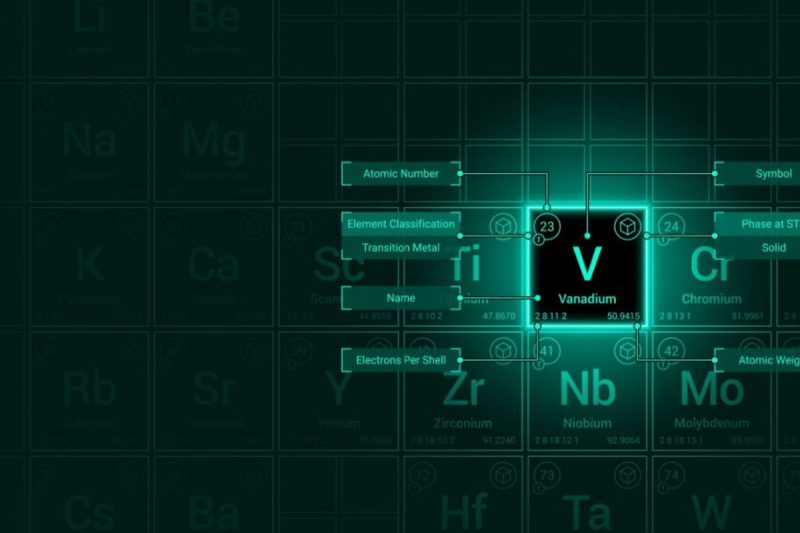Demand for vanadium was projected to continue growing at the end of 2022, with the battery segment receiving special attention from investors amid the world’s ongoing transition away from fossil fuels and toward green energy.
Most vanadium output is used in China for steel applications, particularly the high-strength, low-alloy steel used to make construction rebar. But vanadium’s use in energy storage is boosting interest in this battery metal.
How did vanadium perform in H1 2023?
During the first three months of the year, vanadium oxide pricing continued to rise from 2022 levels as Chinese carbon crude steel production outperformed expectations with a 4.8 percent increase, according to CRU Group data.
According to Project Blue, vanadium prices started picking up in the last months of 2022, with the abrupt reversal in China’s zero-COVID policy. This move triggered hopes for a fast economic recovery, an improvement in the property market and rising steel production.
However, Sardain said he didn’t expect the price correction to be so severe after the March peak.
“We were expecting stronger demand from China and therefore stronger vanadium prices, although some seasonal softening was also expected, especially after stock rebuilding,” he said.
What is the vanadium supply and demand forecast for 2023?
In terms of Chinese demand, the macroeconomic environment is expected to set the tone for what may happen in the second half.
“Steel production has declined in recent months, in line with a weaker manufacturing sector and a property market/construction which failed to recover as expected by the market,” Sardain said. “Some recovery should be expected in late summer in anticipation of China’s ‘second construction season,’ but its magnitude is uncertain.”
A key catalyst to keep an eye on is what stimulus China adopts in the coming weeks and months.
“If nothing tangible is announced, Chinese steel production may well show a year-on-year decline in 2023 vs the 1,013 million tonnes produced in 2022,” Sardain said. “Rebar production could also underperform.”
For the rest of the world, the expert expects the picture to remain unchanged in the second half, with economies on the brink of recession, higher interest rates and a core sticky inflation.
CRU’s Thomas pointed out that production of carbon crude steel is generally lower in H2 relative to H1, with 2023 being essentially flat from last year’s H2.
“With this we forecast a 0.3 percent fall from 2022 total year production in 2023,” he added. “Despite this, global production is forecast to grow 0.9 percent for total year production, as world excluding China production will grow 7.4 percent and 11.7 percent for Q3 and Q4, respectively.”
Looking over to the battery segment, interest in energy storage continues to increase. Vanadium is a key metal used in vanadium redox batteries (VRFBs), which are a viable option for large-scale storage because they are able to provide hundreds of megawatt hours at grid scale.
“Demand will continue to rise in the battery sector as more battery projects continue to take up all the electrolyte production available,” Thomas said. “2024 will see increased gains in electrolyte capacity, driving new demand for vanadium oxides.”
Estimates from Project Blue show that the battery sector used about 5,000 metric tons of vanadium in 2022 versus 2,900 metric tons in 2021, with the bulk coming from China.
“We believe that the VRFB’s market share in battery energy storage will remain at about 1 percent in the coming years, with most of the demand growth coming from China’s new installations,” Sardain said. “Overall, although the vanadium consumption in VRFBs is expected to show a strong demand, it may be lumpy year to year.”
That said, as battery demand grows, the supply side must be ready to meet this increased demand. “There is more than enough vanadium out there. The challenge is building out the value chain in lockstep with increasing demand,” Thomas said.
When looking over at supply in the first half of the year, challenges in the first six months were limited.
“The only real challenge going forward seems to be the increasing demand for high-purity vanadium oxide and further downstream electrolyte capacity,” Thomas said.
Meanwhile, Sardain said the main uncertainty factor for supply, besides unforeseen operational issues, remains flows in the trading of Russian material.
“Clearly, the main supply uncertainty remains about the Russian material, which has been increasingly rejected by traders and purchasers globally (except most likely China),” Sardain said. “However, it is most likely that some Russian vanadium has found its way to China and possibly to other markets.”
What’s ahead for the vanadium market in 2023?
As the second half of the year unfolds, there are several factors that could impact the vanadium market.
Aside from unpredictable shocks, pricing should be supported by increased battery demand, steel production growth in the world excluding China and support from recovering aerospace demand, according to CRU.
“Recent gains in oxide pricing DAP China show the pickup in demand from both alloys and batteries,” Thomas said. “Ex-China ferrovanadium pricing has been soft in recent weeks, but should see support from increased H2 steel production.”
When asked about what catalysts he will be paying attention to in the second half of 2023, Thomas said steel production and battery electrolyte capacity gains will be the primary factors to watch.
Securities Disclosure: I, Priscila Barrera, hold no direct investment interest in any company mentioned in this article.

